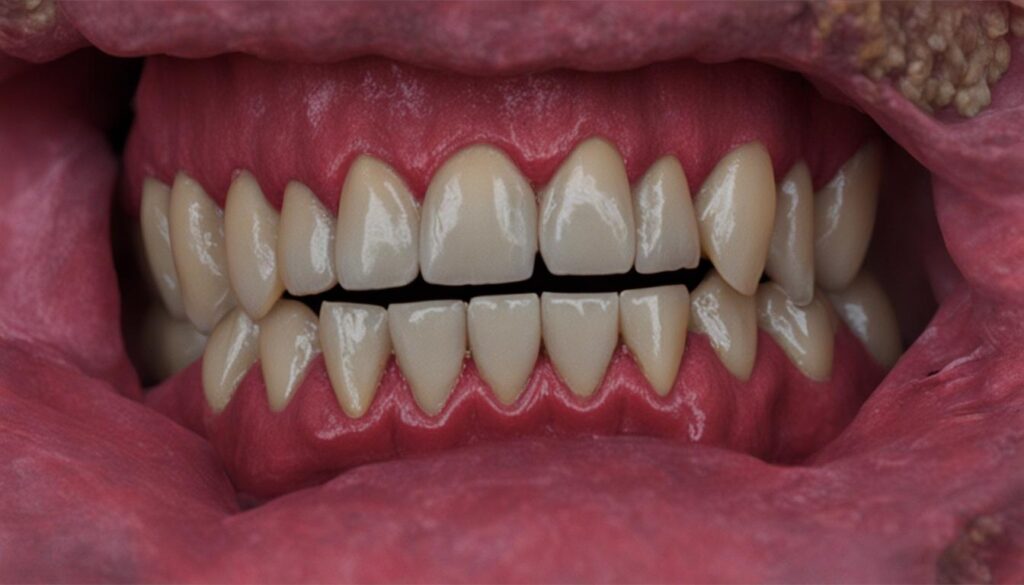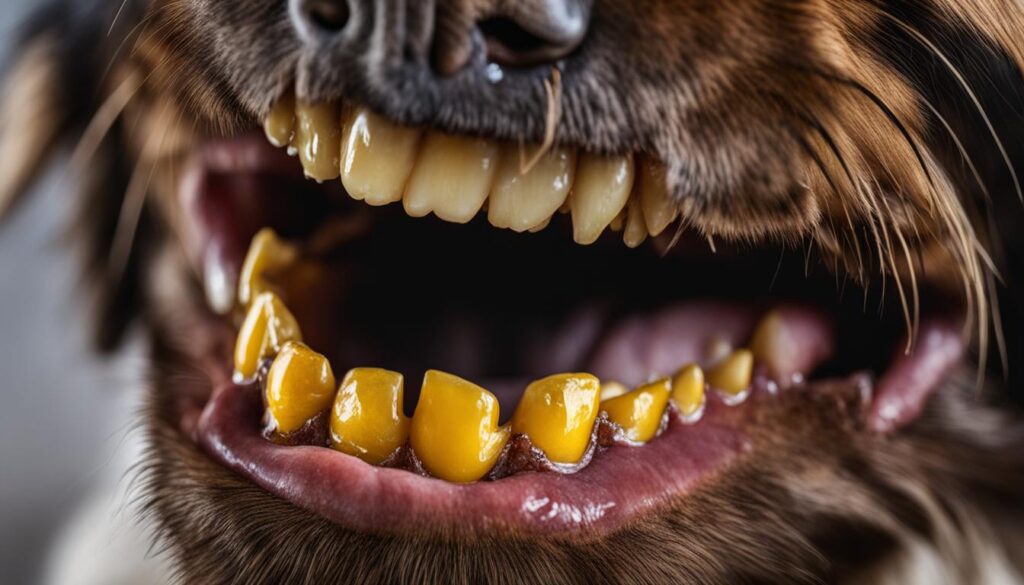Welcome to my comprehensive canine health guide, where we delve deep into understanding your dog’s jaw bone. In this guide, we will explore the intricate details of your furry friend’s dental health and uncover the importance of proper care and maintenance.
As responsible pet owners, it is crucial to be aware of the unique characteristics of your dog’s jaw bone in order to ensure their overall well-being. By understanding the structure, types of teeth, and potential health issues that can affect their jaw, you can provide the necessary care to keep your canine companion healthy and happy.
Key Takeaways:
- Dogs have 42 teeth, with 20 on the top and 22 on the bottom.
- Puppies have 28 teeth before their adult teeth come in.
- Craniomandibular osteopathy is a condition where extra bone forms along the mandible and temporomandibular joint (TMJ) in a dog’s mouth.
- Dental disease is common in dogs, affecting up to 60-80% of them.
- Seek veterinary care if you suspect your dog has dental disease for proper diagnosis and treatment.
The Types of Teeth Dogs Have
Dogs have a variety of teeth that serve different functions in their mouths. Understanding the different types of dog teeth can help you better care for your canine companion’s dental health. A dog’s mouth contains four main types of teeth: incisors, canines, premolars, and molars.
Incisors
Incisors are the small, sharp teeth located at the front of a dog’s mouth. They are used for grasping and nibbling at food. Dogs have a total of 12 incisors, six on the top and six on the bottom.
Canines
Canines, also known as fangs, are the long, pointed teeth located next to the incisors. They are used for tearing and holding onto food. Dogs have a total of four canines, two on the top and two on the bottom.
Premolars and Molars
Premolars and molars are the larger, flatter teeth located towards the back of a dog’s mouth. They are used for grinding and crushing food. Dogs have a variable number of premolars and molars, with the total number depending on the size and breed of the dog. Typically, dogs have four premolars on each side of their upper jaw, and six molars on each side of their upper and lower jaws.
A dog dental chart can provide a visual representation of the arrangement of these different types of teeth in a dog’s mouth. This chart is a useful tool for veterinarians and dog owners alike in identifying and keeping track of the various teeth in a dog’s mouth.
Craniomandibular Osteopathy in Dogs
Craniomandibular osteopathy is a condition that affects a dog’s jaw bones and can cause pain and difficulty in opening the mouth to eat. This condition is characterized by the formation of extra bone along the mandible and temporomandibular joint (TMJ) in the dog’s mouth. It is more commonly seen in certain breeds, such as Scottish Terriers and West Highland White Terriers.
When a dog has craniomandibular osteopathy, the excess bone growth can restrict the movement of the jaw, making it challenging for the dog to chew and eat food properly. It can also be accompanied by symptoms like swelling in the jaw and fever. If you notice any signs of discomfort or difficulty in your dog’s jaw movement, it is important to consult with a veterinarian for a proper diagnosis and treatment plan.
Symptoms and Diagnosis of Craniomandibular Osteopathy
Common symptoms of craniomandibular osteopathy include pain when opening the mouth, difficulty picking up food, and swelling in the jaw. In some cases, the affected area may feel warm to the touch, indicating inflammation. A veterinarian can diagnose this condition through a thorough examination of the dog’s head and may also conduct blood tests and x-rays to confirm the diagnosis. It is crucial to seek veterinary care if you suspect your dog may have craniomandibular osteopathy, as early detection and management can help alleviate the pain and improve your dog’s quality of life.
In the next section, we will explore the treatment options and management strategies for dogs with craniomandibular osteopathy, as well as provide insights into preventing dental disease in dogs to ensure their overall oral health.
Symptoms and Diagnosis of Craniomandibular Osteopathy
Craniomandibular osteopathy, also known as “lion’s jaw” or “westie jaw,” is a condition that affects a dog’s jaw bone, causing pain and difficulty in opening the mouth. If you notice any symptoms of craniomandibular osteopathy in your dog, it’s important to seek veterinary care for an accurate diagnosis and proper treatment.
Common Symptoms
Dogs with craniomandibular osteopathy may experience pain when trying to eat or open their mouths fully. They may show signs of discomfort or difficulty picking up food. In some cases, you may also observe swelling and heat in the jaw area. Additionally, a dog with this condition may have a fever and exhibit weight loss if the pain hinders their ability to eat properly.
Diagnostic Process
If you suspect craniomandibular osteopathy, a veterinarian will conduct a thorough examination of your dog’s head and jaw. This will involve carefully feeling the affected areas, checking for any abnormalities or swelling. The vet may also perform blood tests to rule out other potential causes of jaw pain and inflammation. X-rays can be used to confirm the diagnosis by revealing the characteristic appearance of increased bone density in the mandible and temporomandibular joint.
Once a diagnosis is confirmed, your veterinarian will discuss the best course of treatment for your dog’s condition, taking into consideration the severity of symptoms and the overall health of your pet. Timely diagnosis and appropriate treatment can help manage the pain and discomfort associated with craniomandibular osteopathy, improving your dog’s quality of life.

Treatment and Management of Craniomandibular Osteopathy
When it comes to treating and managing craniomandibular osteopathy in dogs, there are various options available. The specific treatment plan will depend on the severity of the condition and the individual needs of the dog.
In many cases, the primary goal of treatment is to manage the pain and inflammation associated with the condition. This often involves the use of anti-inflammatory drugs and pain relievers prescribed by a veterinarian. These medications can help alleviate discomfort and improve the dog’s ability to eat and open its mouth.
When Surgery Becomes Necessary
In more severe cases of craniomandibular osteopathy, where the condition significantly impairs the dog’s quality of life, surgical intervention may be recommended. Dog jaw surgery can involve removing the excess bone deposits and repairing any structural abnormalities in the jaw.
Surgery can provide long-term relief and improve the dog’s ability to eat and open its mouth comfortably. However, it is important to note that surgery is typically considered a last resort and is only done when non-surgical treatments have failed to provide adequate relief.
Regular follow-up visits with a veterinarian are crucial for monitoring the dog’s progress and making necessary adjustments to the treatment plan. These visits also allow the vet to assess the dog’s overall health and nutrition, ensuring optimal well-being.
Dental Disease in Dogs
As responsible pet owners, it is crucial to prioritize our dogs’ dental health. Dental disease is a common issue in dogs, affecting a significant percentage of them. This condition can cause discomfort, pain, and even lead to more serious complications if left untreated. That is why canine dental care should be a top priority for every dog owner.
There are various factors that can contribute to dental disease in dogs. Chewing on hard objects, trauma to the mouth, and poor oral hygiene are among the causes. It is important to be aware of the signs of dental disease, including bad breath, tartar buildup, and inflamed gums. Regular dental examinations by a veterinarian can help detect dental disease early on, ensuring prompt treatment and prevention of further complications.
Prevention and Treatment of Dental Disease
Preventing dental disease in dogs involves a combination of professional veterinary care and regular home dental care. A veterinarian can provide guidance on dental hygiene practices and recommend suitable products, such as toothbrushes and toothpaste designed specifically for dogs. Additionally, regular dental cleanings performed by a veterinarian can remove plaque and tartar buildup, reducing the risk of dental disease.
Home care plays a crucial role in maintaining good dental health for dogs. This includes regular tooth brushing and providing appropriate chew toys that promote dental hygiene. It is important to choose chew toys that are safe for dogs and can effectively clean their teeth while they chew. By implementing these preventive measures and seeking veterinary care when needed, we can help ensure our dogs have healthy and happy smiles.
Causes and Symptoms of Dental Disease
Dental disease in dogs can have various causes and can present with a range of symptoms. Understanding these causes and recognizing the signs of dental disease are essential for maintaining your dog’s oral health.
Causes of Dental Disease in Dogs
Several factors can contribute to the development of dental disease in dogs. One common cause is the buildup of plaque and tartar on the teeth, which can lead to gum disease, tooth decay, and bad breath. Additionally, certain breeds may be more prone to dental issues due to their genetics or the shape of their mouths. Chewing on hard objects, such as rocks or bones, can also cause dental damage and contribute to the development of dental disease in dogs.
Signs of Dental Disease
It’s important to be aware of the signs that may indicate your dog is suffering from dental disease. Bad breath is a common early sign, as well as yellowing or discoloration of the teeth. You may also notice swollen or bleeding gums, difficulty eating or chewing, and a reluctance to play with chew toys. If your dog exhibits any of these symptoms, it’s crucial to seek veterinary care promptly to prevent further complications.
Complications of Dental Disease in Dogs
Dental disease in dogs can have serious complications if left untreated. The most common complication is difficulty eating and malnutrition. When a dog’s teeth are painful or damaged, they may struggle to chew their food properly, leading to a decrease in appetite or weight loss. Over time, this can result in nutritional deficiencies and overall poor health.
In addition to difficulty eating, dental disease can also allow bacteria to enter the bloodstream. This can lead to a condition called bacteremia, where bacteria circulating in the blood can infect other organs and worsen existing health conditions. Dogs with heart disease, kidney disease, or compromised immune systems are especially at risk for these complications.
To prevent these complications, it is essential to address dental disease in dogs promptly. Regular dental care, including professional cleanings and at-home tooth brushing, can help maintain good oral hygiene and prevent the progression of dental disease. Consulting with a veterinarian and following their recommended treatment plan is crucial for ensuring the overall health and well-being of your furry friend.
Risks of Dental Disease in Dogs
Dental disease in dogs poses various risks to their health and quality of life. One of the primary risks is the development of oral infections, which can cause pain, swelling, and discomfort. These infections can spread to other parts of the body, leading to more severe health issues.
Another risk of dental disease is the potential for tooth loss. As the disease progresses, it can cause damage to the gums, jawbone, and surrounding tissues, leading to loose or missing teeth. Tooth loss not only affects a dog’s ability to eat but can also impact their overall appearance and self-esteem.
Furthermore, untreated dental disease can have systemic effects on a dog’s overall health. The chronic inflammation and infection associated with dental disease can strain the immune system and contribute to the development or worsening of other health conditions, such as diabetes, respiratory problems, and cardiovascular disease.

Seeking Veterinary Care for Dental Disease
If you suspect that your dog is suffering from dental disease, it is crucial to seek veterinary care promptly. A qualified veterinarian can examine your dog’s mouth to assess the severity of the dental disease and provide an accurate diagnosis. During the dental examination, the vet will thoroughly evaluate your dog’s teeth, gums, and overall oral health.
The dental examination may involve taking x-rays to identify any underlying dental issues that may not be visible to the naked eye. This comprehensive assessment allows the veterinarian to formulate an appropriate treatment plan tailored to your dog’s specific needs.
Why Veterinary Care is Important
Veterinary care is essential for dental disease management for several reasons. Firstly, a vet can professionally clean and scale your dog’s teeth to remove plaque and tartar buildup. This procedure helps prevent further progression of dental disease and reduces the risk of complications.
In addition to dental cleaning, a veterinarian can also perform necessary dental procedures, such as tooth extractions or repairs, under anesthesia if required. Anesthesia ensures your dog’s comfort during the procedure and allows for a thorough examination and treatment.
Furthermore, a vet can provide guidance on home dental care techniques, including tooth brushing and appropriate chew toys. By following their advice, you can maintain your dog’s oral hygiene and prevent the recurrence of dental disease.
Remember, early detection and intervention are key to preventing dental disease from progressing and causing discomfort to your furry friend. Regular veterinary check-ups and proper dental care can help ensure your dog’s dental health and overall well-being.
Dental Procedures for Dogs
Ensuring proper dental care for your dog is essential in maintaining their overall health and well-being. Just like humans, dogs can develop dental issues that require professional intervention. When it comes to dental procedures for dogs, one common recommendation is a comprehensive oral health assessment and treatment (COHAT). This procedure typically involves a thorough cleaning of the teeth under general anesthesia, including scaling and polishing.
During a COHAT, your veterinarian will carefully examine your dog’s teeth and gums to identify any signs of dental disease or other oral health issues. The procedure may also include dental X-rays to assess the health of the tooth roots and jawbone. Scaling involves the removal of plaque and tartar buildup from the teeth, while polishing helps smooth the tooth surface, making it more resistant to future plaque accumulation.
In some cases, tooth extractions may be necessary if a tooth is severely damaged, infected, or causing discomfort for your dog. Your veterinarian will carefully consider the overall dental health of your dog and the specific circumstances before recommending extractions. The procedure will be performed with utmost care to minimize any discomfort or pain for your furry friend.
It’s important to note that dental procedures for dogs are typically performed under general anesthesia. This ensures that your dog is comfortable and relaxed throughout the procedure, as well as allows the veterinarian to safely and effectively perform the necessary dental work. Your veterinarian will closely monitor your dog’s vital signs during the procedure and take appropriate measures to ensure their safety.
Image: Dog Dental Cleaning
Home Care and Prevention of Dental Disease
When it comes to keeping your furry friend’s teeth healthy and preventing dental disease, a little bit of effort can go a long way. By incorporating regular at-home dental care into your dog’s routine, you can help maintain their oral hygiene and reduce the risk of dental issues.
Establish a Tooth-Brushing Routine
One of the most effective ways to prevent dental disease in dogs is by brushing their teeth regularly. Use a dog-friendly toothbrush and toothpaste, as human products can be harmful to them. Start slow and gradually increase the duration of brushing as your dog becomes more comfortable. Aim for at least three times a week, but ideally, brush their teeth daily to remove plaque and prevent tartar buildup.
Provide Appropriate Chew Toys
Chew toys can help keep your dog’s teeth clean and their jaws strong. Look for toys that are designed to promote dental health, such as those with ridges or nubs that can help remove plaque as your dog chews. Avoid hard toys that could potentially damage their teeth and opt for dental-specific chew toys that are approved by veterinarians.
Regular Vet Check-Ups
Regular visits to the veterinarian are essential for monitoring your dog’s dental health. Your vet can perform a thorough examination of your dog’s mouth, check for any signs of dental disease, and provide professional dental cleanings if necessary. They can also offer advice on maintaining your dog’s dental hygiene and answer any questions or concerns you may have.
By implementing these home care practices and working closely with your veterinarian, you can help ensure that your dog’s teeth stay healthy and prevent the development of dental disease. Remember, prevention is always better than intervention when it comes to your furry companion’s oral health.
Conclusion
I hope this canine health guide has provided you with valuable insights into understanding and caring for your dog’s jaw bone and dental health. Just like humans, dogs rely on their teeth and jaw bone for various essential functions, from eating to playing. By taking proactive steps to maintain their oral hygiene, you can ensure that your furry friend enjoys a healthy and pain-free mouth.
Regular veterinary check-ups are crucial for monitoring your dog’s dental health. Your veterinarian can assess the condition of their jaw bone and teeth, provide necessary treatments, and offer guidance on at-home care. Remember, prevention is key! Incorporating simple dental care practices into your routine, such as tooth brushing and using appropriate chew toys, can significantly reduce the risk of dental disease in your dog.
By prioritizing your dog’s jaw bone health and dental well-being, you are contributing to their overall quality of life. A healthy mouth not only prevents discomfort and pain but also promotes proper digestion and overall systemic health. So, be a responsible pet parent and give your furry companion the care they deserve by paying attention to their dental health. Your dog will thank you with a happy and vibrant smile!
FAQ
How many teeth do dogs have?
Dogs have a total of 42 teeth, with 20 on the top and 22 on the bottom.
How many teeth do puppies have?
Puppies have a total of 28 teeth before their adult teeth come in.
What should I do if my dog has a broken or missing tooth?
It is important to contact a vet if your dog has a broken or missing tooth.
What types of teeth do dogs have?
Dogs have different types of teeth, including incisors, canines, premolars, and molars.
What is craniomandibular osteopathy?
Craniomandibular osteopathy is a condition where extra bone forms along the mandible and temporomandibular joint (TMJ) in a dog’s mouth.
Which dog breeds are commonly affected by craniomandibular osteopathy?
Certain breeds, such as Scottish Terriers and West Highland White Terriers, are more commonly affected by craniomandibular osteopathy.
What are the symptoms of craniomandibular osteopathy?
Common symptoms of craniomandibular osteopathy include pain when opening the mouth, difficulty picking up food, fever, and swelling in the jaw.
How is craniomandibular osteopathy diagnosed?
A veterinarian can diagnose craniomandibular osteopathy through a thorough examination of the dog’s head, and may also conduct blood tests and x-rays.
What is the treatment for craniomandibular osteopathy?
Treatment for craniomandibular osteopathy involves managing pain and inflammation with anti-inflammatory drugs and pain relievers, and in some cases, surgery may be necessary.
How common is dental disease in dogs?
Dental disease is common in dogs, affecting up to 60-80% of them.
What are the symptoms of dental disease in dogs?
Symptoms of dental disease in dogs may include bad breath, yellowing or tartar buildup on teeth, sensitivity to hard foods, and gum inflammation.
What are the complications of dental disease in dogs?
Severe dental disease can lead to difficulty eating, malnutrition, and allow bacteria to enter the bloodstream and worsen other health conditions.
What should I do if I suspect my dog has dental disease?
If you suspect your dog has dental disease, it is important to seek advice from a veterinarian for examination and treatment options.
What is a comprehensive oral health assessment and treatment (COHAT)?
COHAT is a procedure that involves a thorough cleaning of the dog’s teeth under general anesthesia, including scaling, polishing, and potentially tooth extractions.
How can I prevent dental disease in dogs?
Regular at-home dental care, such as tooth brushing and providing appropriate chew toys, can help prevent dental disease in dogs.



